BDO & PitchBook: Natural Resources M&A Report
Table of Contents:
- After a Drought, A Flood of Capital and Deal Activity on the Horizon for Oil & Gas
- Eyeing Sector Challenges, Private Equity Looks Elsewhere
- Record Lows Preface Record M&A Activity
- Diverging Paths: Upstream vs. Midstream
- Looking Ahead: Investment and the Ultramajors Come Calling
After a Drought, A Flood of Capital and Deal Activity on the Horizon for Oil & Gas
Since 2014, oil and gas companies—particularly those upstream—have had to reorient their organizations to operate in a low-price environment.
In order to compete, they’ve gotten better at doing more with less, and streamlining their value proposition. While technological advancements like horizontal drilling and hydraulic fracturing have unleashed a revolution catapulting the U.S. up the ranks as a global producer, it was made possible largely by the availability of capital and debt financing from both banks and equity sales. Due to the tighter margins and uncertain returns in a more volatile price environment, those same investors and private equity firms have been more reticent to spend in the sector.
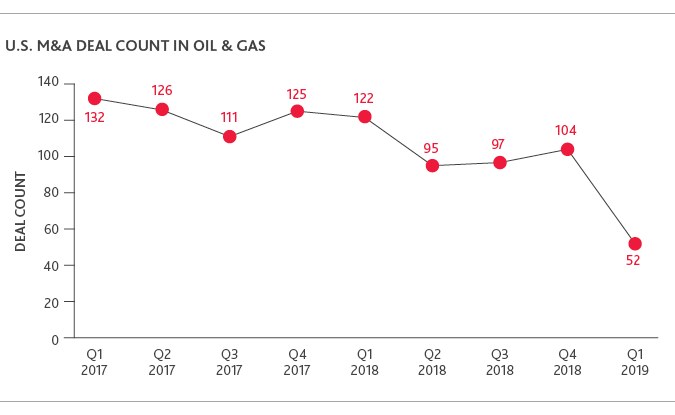
What has followed in the last two years is record lows for M&A activity in the space, decreasing PE involvement and what may be a permanent shift away from IPOs as the ultimate exit path for companies in the space.
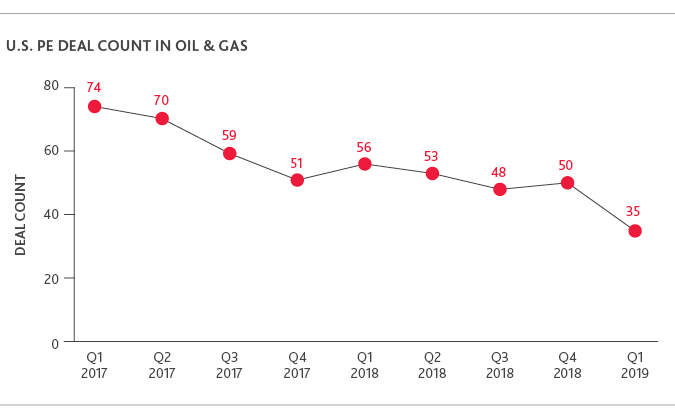
While the last several years have presented a challenging landscape for the sector, there is reason to expect that the drought of capital will break in the coming year, resulting in a flood of M&A and private equity activity in 2019 and 2020. Though this volatile, low-price environment is likely to persist—and a potential downturn lurks—healthier balance sheets of the largest oil companies and an emphasis on capital discipline for producers presents a prime opportunity for acquisitions, divestitures, mergers and investment in the sector.
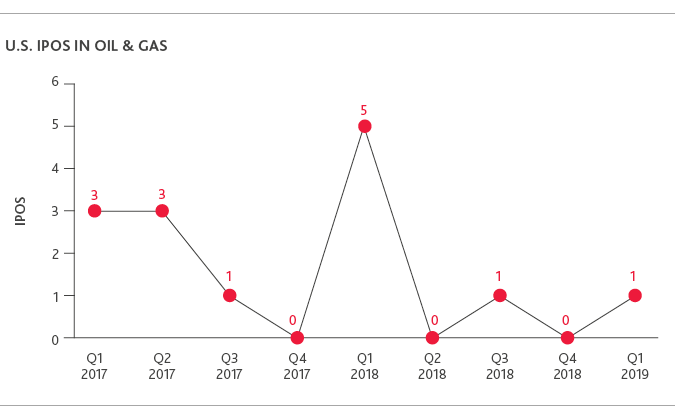
Eyeing Sector Challenges, Private Equity Looks Elsewhere
Private equity activity in the oil and gas sector has declined significantly since 2017, with deal count dropping nearly 50 percent.
In keeping with wider trends beyond the oil and gas sector in PE, deal value has remained relatively steady, as has deal count—though ultimately trending downward outside of activity in Q3 2018. As such, and like deal activity overall, both PE deal count and value saw record lows in at the start of 2019, with only 35 deals totaling $5.3 billion recorded in Q1 2019.
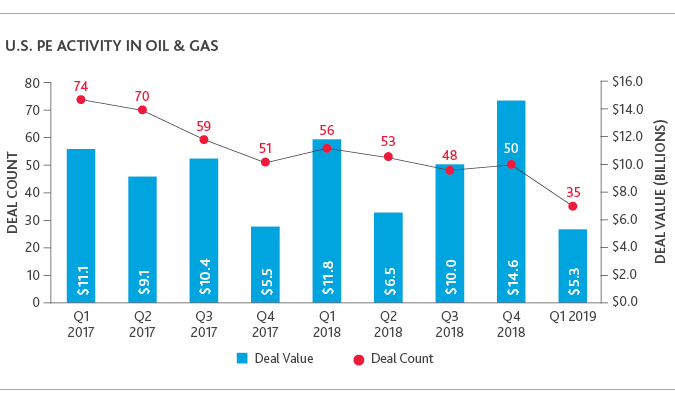
Increased competition empowered by digital transformation is playing an active role in private equity’s aversion to the oil and gas sector and its assets. Respondents to BDO’s latest Private Equity PErspectives Survey cited more agile competitors (29 percent) and disruptive business models (22 percent) as the top two digital threats by private equity firms to their portfolio companies.
At the same time, private equity firms cited the natural resources industry among those most likely to see decreasing deal activity in the coming year.

Record Lows Preface Record M&A Activity
Tighter margins from a lower price environment have exacerbated the struggles of oil and gas companies to attract capital or acquisition interest, snowballing to the slowest quarter for M&A activity since the 2014 price crash—and a 60 percent drop from Q1 2017 alone, according to PitchBook data.
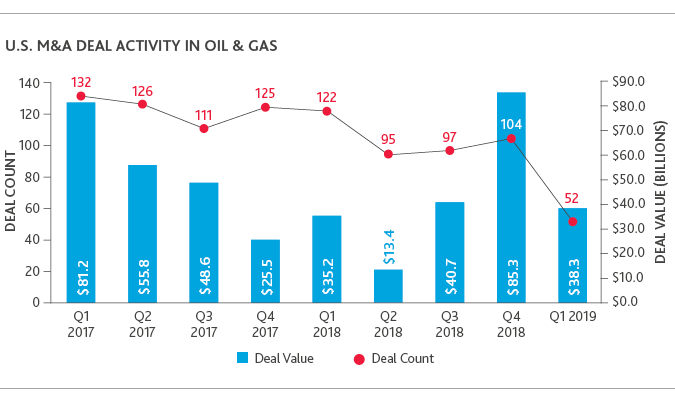
However, the challenging market conditions that have led to a suppressed deal environment may also have set the stage for increased deal activity to come in 2019 and 2020. In this light, 2018’s spike in deal value and deal count—representative of BP’s acquisition of BHP Billiton’s Permian, Eagle Ford and Haynesville assets for $10.5 billion dollars and Diamondback’s $9.2 billion-dollar acquisition of Energen—can be taken as a harbinger of things to come. As the oil majors and independents alike seek to strengthen their position in the growing U.S. shale and natural gas markets, there are signs of record deal activity in the works.
2019 has already seen the largest acquisition in the sector to date, following Chevron and Occidental Petroleum’s bidding war over Anadarko Petroleum driven by the attractiveness of the latter’s Permian assets and the growing importance of shale in the sector. Success for Occidental following the record $38 billion-dollar deal will hinge on satisfying shareholders by applying Oxy’s technological know-how to Anadarko’s Texas and Colorado assets to create both cost savings and added value—and quickly shedding Anadarko’s non-shale assets. The divestiture of these assets creates opportunities downstream and for midstream companies to streamline their own portfolios. It also raises the bar for efficiency, production and competitiveness in the Permian and other areas like it—and presents an opening for private equity to return to the sector.
Diverging Paths: Upstream vs. Midstream
This paradoxical environment—of production growth but market challenge—has manifested acutely in the financial performance of upstream organizations, who have seen an exodus of capital and struggled in the market.
Over the last two years alone, upstream deal activity dropped 68 percent—more drastic than the decline for the industry overall. In the midstream, where rising demand to address skyrocketing U.S. production growth has attracted interest in the sector, deal activity has held steadier, though deal count also declined to lows in Q1 2019. Long lead-times for projects and volatile prices have left a question hanging over industry as to whether supply will be met, but investors have regarded the sector as a safer bet.
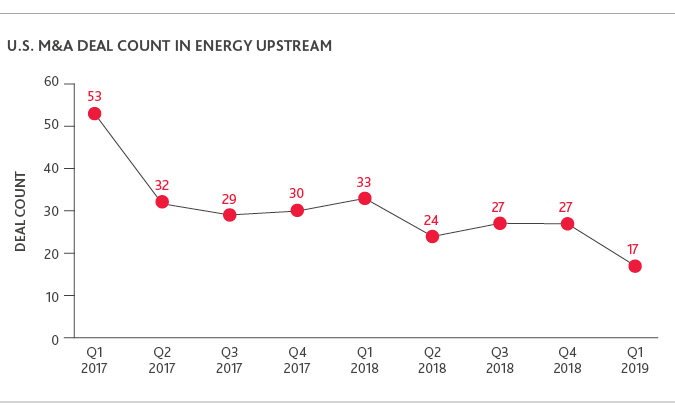
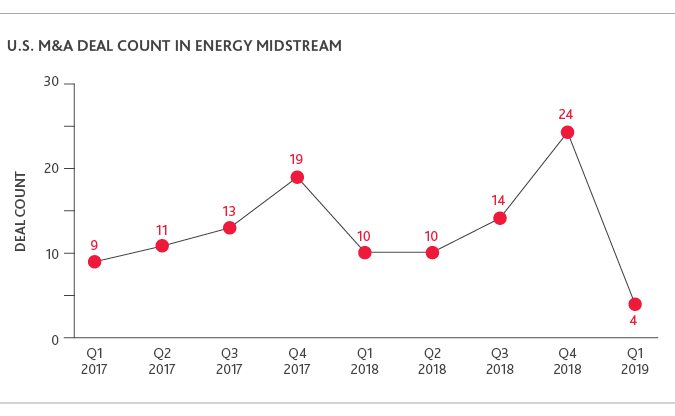
While the midstream has been viewed more positively than its upstream counterpart, recent regulatory changes around the 2017 Tax Cuts and Jobs Act negatively impacting the sector have made it less appealing to investors than prior years—and some of the uptick in midstream M&A in 2017 and 2018 came as a market reaction.
By lowering the corporate tax rate overall, the TCJA reduced the attractiveness of Master Limited Partnerships as an investment option. On the heels of tax reform, the Federal Energy Regulation Commission (FERC) initially proposed placing severe limitations on the deductions that shareholders could claim, although they softened their approach in their final ruling.
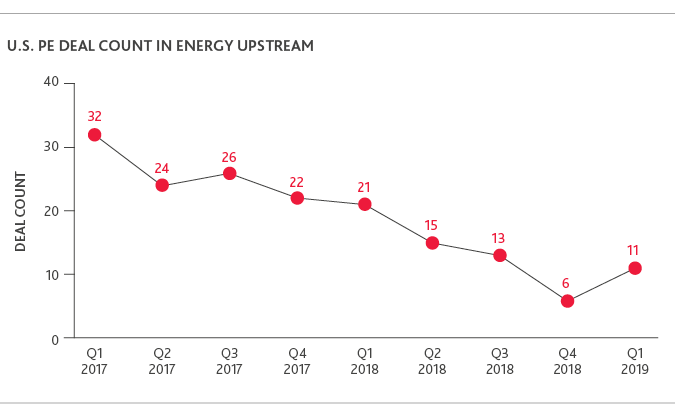

Looking Ahead: Investment and the Ultramajors Come Calling
With American oil and gas output expected to increase to 12.4 million b/d in 2019 and 13.3 million b/d in 2020, pressure on the sector—particularly for exploration and production companies—will continue.
In the wake of acquisitions by BP and Occidental Petroleum, expect other super- and ultramajors to carve out their own deals in the Permian Basin. All eyes in the industry are on the major independents and middle market producers who, having learned to maximize efficiency and capital discipline in order to survive, may seek out acquisitions. For private companies, mergers or acquisitions rather than IPOs present a path forward in a more volatile, low-price environment. These market conditions are expected to continue, particularly with increased geopolitical uncertainty on the horizon.
And just as technological advancement by independent exploration and production companies allowed for the growth and development of production in the Permian Basin, these same companies are now seeing ultramajors moving into their domain—with the capital to develop and deploy the latest technology at scale. Though oil prices are unlikely to rise again to 2014 highs, the full coffers and record profits of the majors, combined with the revolutionary power and efficiency of digital transformation in the oil and gas sector, has made the oil and gas sector—particularly upstream—ripe for consolidation.
“What we’re seeing in these hotbeds of activity like the Permian Basin is a revolution in oil and gas akin to the mass commercialization of the Model T. The majors are bringing factory-style production to shale and natural gas, once the purview of smaller organizations, making it tougher for those with less capital and lower margins to compete with the production efficiencies you gain at scale.”
Clark Sackschewsky
BDO’s National Natural Resources Practice Leader
Have Questions? Contact Us
SHARE